#Visualize Data with Charts and Graphs
Explore tagged Tumblr posts
Text
Elevate Client Services with Excel: Expert Tips for Financial Consultants by Grayson Garelick

Financial consultants operate in a dynamic environment where precision, efficiency, and client satisfaction are paramount. Excel, as a versatile tool, offers an array of features that can significantly enhance the services provided by financial consultants. Grayson Garelick, an accomplished financial analyst and consultant, shares invaluable Excel tips to help financial consultants elevate their client services and add tangible value.
The Role of Excel in Financial Consulting
Excel serves as the backbone of financial consulting, enabling consultants to analyze data, create models, and generate insights that drive informed decision-making. As the demands of clients become increasingly complex, mastering Excel becomes essential for financial consultants aiming to deliver exceptional services.
1. Customize Excel Templates
One of the most effective ways to streamline workflows and improve efficiency is by creating customized Excel templates tailored to specific client needs. Grayson suggests developing templates for budgeting, forecasting, and financial reporting that can be easily adapted for different clients, saving time and ensuring consistency.
2. Utilize PivotTables for Data Analysis
PivotTables are powerful tools in Excel that allow financial consultants to analyze large datasets and extract meaningful insights quickly. Grayson emphasizes the importance of mastering PivotTables for segmenting data, identifying trends, and presenting information in a clear and concise manner to clients.
3. Implement Conditional Formatting
Conditional formatting is a valuable feature in Excel that allows consultants to highlight important information and identify outliers effortlessly. By setting up conditional formatting rules, consultants can draw attention to key metrics, discrepancies, or trends, facilitating easier interpretation of data by clients.
4. Leverage Excel Add-ins
Excel offers a variety of add-ins that extend its functionality and provide additional features tailored to financial analysis and reporting. Grayson recommends exploring add-ins such as Power Query, Power Pivot, and Solver to enhance data manipulation, modeling, and optimization capabilities.
5. Automate Repetitive Tasks with Macros
Macros enable financial consultants to automate repetitive tasks and streamline workflows, saving valuable time and reducing the risk of errors. Grayson advises recording and editing macros to automate tasks such as data entry, formatting, and report generation, allowing consultants to focus on value-added activities.
6. Master Advanced Formulas and Functions
Excel's extensive library of formulas and functions offers endless possibilities for financial analysis and modeling. Grayson suggests mastering advanced formulas such as VLOOKUP, INDEX-MATCH, and array formulas to perform complex calculations, manipulate data, and create sophisticated models tailored to client needs.
7. Visualize Data with Charts and Graphs
Visualizing data is essential for conveying complex information in an easily digestible format. Excel offers a variety of chart types and customization options that enable consultants to create compelling visuals that resonate with clients. Grayson recommends experimenting with different chart styles to find the most effective way to present data and insights.
8. Collaborate and Share Workbooks Online
Excel's collaboration features enable financial consultants to work seamlessly with clients, colleagues, and stakeholders in real-time. Grayson highlights the benefits of sharing workbooks via OneDrive or SharePoint, allowing multiple users to collaborate on the same document, track changes, and maintain version control.
9. Protect Sensitive Data with Security Features
Data security is a top priority for financial consultants handling sensitive client information. Excel's built-in security features, such as password protection and encryption, help safeguard confidential data and ensure compliance with regulatory requirements. Grayson advises implementing security protocols to protect client data and maintain trust.
10. Stay Updated with Excel Training and Certification
Excel is a constantly evolving tool, with new features and updates released regularly. Grayson stresses the importance of staying updated with the latest Excel training and certification programs to enhance skills, explore new capabilities, and maintain proficiency in Excel's ever-changing landscape.
Elevating Client Services with Excel Mastery
Excel serves as a catalyst for innovation and excellence in financial consulting, empowering consultants to deliver exceptional services that add tangible value to clients. By implementing Grayson Garelick Excel tips, financial consultants can streamline workflows, enhance data analysis capabilities, and foster collaboration, ultimately driving client satisfaction and success. As financial consulting continues to evolve, mastering Excel remains a cornerstone of excellence, enabling consultants to thrive in a competitive landscape and exceed client expectations.
#Financial Consulting#grayson garelick#Customize Excel Templates#Utilize PivotTables#Implement Conditional Formatting#Leverage Excel Add-ins#Automate Repetitive Tasks with Macros#Advanced Formulas and Functions#Visualize Data with Charts and Graphs#Collaborate and Share Workbooks#Protect Sensitive Data with Security#Stay Updated with Excel Training#Elevating Client Services with Excel
3 notes
·
View notes
Text

The rapid change in how people got around in New York City, 1913-1916. Graphic presentation. 1939.
Prelinger Library via Internet Archive
#charts#chart#transportation#nyc#automobile age#horse#horses#graphs#visual data#graphic design#nemfrog#1910s#1939
224 notes
·
View notes
Text
Making weekly progress graphs
All it took was one (1) person asking about it and I decided to make a post for how to make my progress graphs. Maybe I've done this before. I don't know. I'm doing it now.
For what I do, I use a spreadsheet. It's google docs right now, but I assume you can use anything because I'm not using anything unique to google docs.
You need at least 2 tabs. I have more than that, but let's start here.
Tab 1: Wordcounts
My first tab is called "WIP Progress". Here's what it looks like:

That's one line per WIP per day, if I work on it.
Month and Week are columns derived from the Date column using formulas.
Want the actual formulas? Month is "=concatenate(year(C2), ", ", month(C2))" and Week is "=concatenate(year(C2),", ", text(weeknum(C2-1), "00"))", at least in row 2.
Date column is the day you worked on it, hand entered.
Fic is a title per WIP. You should keep the title the same for each WIP because this will be used to track progress in graphs.
Detail is a note column, doesn't have to be unique. I use it to figure out working ideas and track parts of things. Like, parts 1 and 2 of the Prophetic D&D game are under the same Fic name with the actual title in the Detail column
Start wc is the number of words on that WIP at the start of the day
End wc is the number of words on that WIP at the end of the day
Total is a math formula that does the difference between Start wc and End wc. Literally just "=G2-F2"
And then every day, I add as many lines as things I'm working on and copy the formulas from a previous row and adjust them. So, for today, it looks like this:

Insert rows, copy, paste, change the dates, copy End wc to Start wc, and I'm ready to go.
How long have I been doing this? ...

A while.
More formula and some graphs behind the cut.
Tab 4: Last Week Progress
Let's skip to tab 4 because that's where my graphs come from. Tab 2 is "Progress by Day" and Tab 3 is "Progress by Week" but we'll come back to those if anyone is interested.

Okay, so the general idea is that it looks back 7 days and does a count of how many words, the average (ignoring 0s), and the counts per work per day. Then it graphs them. So how does this work?
Well, the top row is my constants:
Formula in F2: "=averageif($D3:$N10,"<>0")"
Formula in H2: "=MINIFs($D3:$N10, $D3:$N10, "<>0")"
Formula in J2: "=MAXIFS($D3:$N10, $D3:$N10, "<>0")"
The words "Word Documents" is in L2 because I use it in my unique filter. I used to keep track of my work writing but I didn't want it in this graph, so it's filtered out.
Rows 2 through 10 are my data rows. Here's what they look like:
A3: "=TODAY()", A4: "=A3-1", A5: "=A4-1". Follow that pattern as far back as you want to look.
B3: "=sumif('WIP Progress'!C:C,A3,'WIP Progress'!H:H)". Copy that down the column as far as you put down dates. That's give you your daily wordcount.
C3-C10: "=$F$1". Literally that's it. Just inserting the calculated average so that I can graph it nicey.
Tricky bit! D2 is a complicated formula. It looks like: "=transpose(sort(unique(filter('WIP Progress'!D:D, 'WIP Progress'!C:C>=today()-8,ARRAYFORMULA(if(not(exact('WIP Progress'!D:D, 'WIP Progress'!$D$1))*not(exact('WIP Progress'!D:D, $L$1)), True, false))))))"
EDIT! There's a better way that doesn't use ARRAYFORMULA. It's still a monster, but ARRAYFORMULA only works in google sheets. See my reblog of this post for an update:
... Yeah, that's a monster. What it's doing is taking the rows in my WIP Progress tab and filtering out anything that's not within the last 8 days. If you go back more than a week, change the number in the part that says ">=today()-8" to something higher. Then it also removed anything that matches my header row in WIP Progress, and also anything that matches my filter field ("Work Documents"). And then it takes all the unique values of what it finds, sorts them into alphabetical order, and transposes them so that they go in as column headers. This means the column headers change if I add more things to my daily wordcounts, and they stick around for the week.
Anyway, that's what determines the column headers for columns D through M. I've never written on more than 10 WIP in a week, so I've never needed more than that.
For cell D3, I have this formula: "=sumifs('WIP Progress'!$H$1:$H, 'WIP Progress'!$D$1:$D, D$2, 'WIP Progress'!$C$1:$C, $A3)". That is then copied and pasted into the rectangle of numbers there. Everything that needs to change will change, and everything that doesn't won't.
What's it do? Well, it matches the header of the column (D$2, E$2, F$2...) to the date on the lefthand side ($A3, $A4, $A5...) and then does a sum of the values for wordcount that match that column and that date. So if for some reason I have two entries for a WIP on the same date, it'll add them up.
Why would I have this? Sometimes I move stuff to a different document and start a new line with new start wc and end wc. It happens.
Okay, all the formulas are in! Now I have a bunch of numbers. How do I make a graph? This is easier through screenshots:

Go to Edit chart. Again, this is the googs, so if you're in Excel you'll have to look up how to do it differently.

In Setup, this is a Smooth line chart. The data range has the columns from my table above, with a little extra because I think maybe I started with 2 weeks worth. Whatever, extra is fine.
X-axis is Days, which is the first column. Then the series that get plotted are basically one of each column, except for Words because it threw things off.
Series view:

All the blank ones are on here because they don't show up if they've got no data. Well, technically they do but they're all at the 0 line so it just looks darker.
Also helpful:

Next, Customize the chart:

Mostly boring defaults, but here's the place to set the title.
And that's how the chart gets made. I have more charts than this, though...



So many more charts...
I'm willing to write more about them or help with formulas if anyone wants to know more.
#my writing#data visualization#someday i'll actually read that data viz book#i'm an amateur at this#charts and graphs#math
25 notes
·
View notes
Text


Responsive graphs and charts in Figma
Made with Extrabold UI
Try the free version https://extraboldui.com
3 notes
·
View notes
Text
tumblr's reblog graph is one of the most beautiful things i have ever seen. what incredible data visualization.
#reminds me of the greater los angeles polycule chart#gay people#tumblr#data#data visualization#graphs
3 notes
·
View notes
Text
2 notes
·
View notes
Text

Life Expectancy vs. Health Expenditure
The graph
1 note
·
View note
Text
Graphy.app Data Visualization Made Easy (and Fast!)
Stop struggling with data! Graphy.app makes creating beautiful, impactful graphs a breeze. See how easy it is!" #datavisualization #graphs #dataanalysis #graphyapp #productivity #businesstools #analytics
Don't forget to like, comment, and subscribe for more AI content!
#impactful graphs a breeze. See how easy it is!"#datavisualization#graphs#dataanalysis#graphyapp#productivity#businesstools#analytics#Don't forget to like#comment#and subscribe for more AI content!#“data visualization”#“graph maker”#“create graphs”#“data analysis tools”#“chart maker”#“easy data visualization”#“online graph maker”#“ai graph generator”#“data visualization software”#“business graph maker”#“data reporting tools”#“interactive graph maker”#“data dashboard tools”#“graph creation online”#“data presentation tools”#“google sheets graph integration”#“notion graph integration”#“business intelligence tools”#“analytics software”
0 notes
Text
Data Visualization
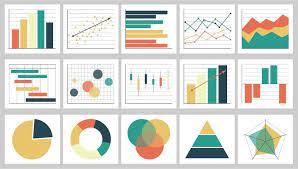
Data Visualization present complex data in a way it easy to convey an overall message, highlight key insights,and guiding an audience toward a conclusion. In other words, Data Visualization deals with the presentation of complex information effectively. it represents data and information in a graphical manner that is easy to comprehend. Visualizations include charts, graphs, maps, infographics, and other elements. They can assist in decision making process, allocation of funds to various departments etc.,
Benefits:
Effective in converting complex data that it is easy to comprehend and understand.
Generating insights and trends by analyzing big data.
Developing an effective Business strategy.
Risk Management
Use an appropriate chart that is relavent to your presentation viz line chart to display trends, scatter charts to show corelations etc.,
Check out our master program in Data Science and ASP.NET- Complete Beginner to Advanced course and boost your knowledge.
URL: www.edujournal.com
0 notes
Video
youtube
Mastering Data Visualization: Learn How to Create Stunning Stacked Chart...
#youtube#canva#Canva tutorial#Canva tips#graphs#Canva love#Canva charts#Canva graphs#tutorial#graphic design#design tutorial#Stacked charts#video tutorial#data visualization
0 notes
Text
Big Radqueer Survey Results
This is going to be pretty long. I may in the future take sections from this (+ maybe elaborate) and make them their own posts. Disclaimer that any viewpoints discussed below are not necessarily my own and that I am trying to approach this from a place of pure curiosity and am not including my own moral stances. Thank you everyone for taking the survey. We’ll get started under the read more!
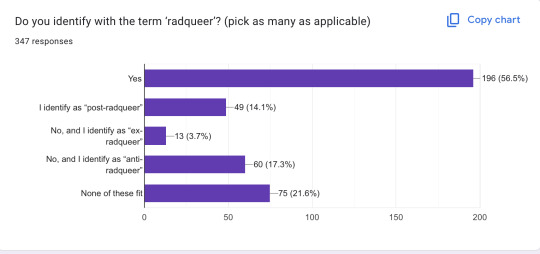
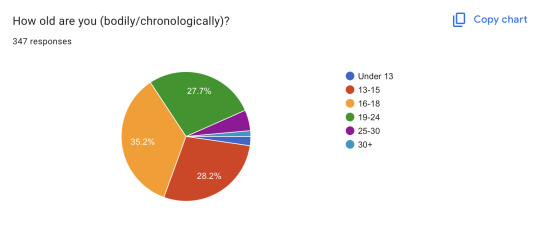
Alright, so immediately we’re working with a large radqueer majority audience, so keep that in mind! There is some diversity overall, but this did end up being a very pro-radqueer heavy population. Fairly normal age distribution compared to the rest of tumblr, I’d say, though I would take note of the majority 13-18 population and significant under 16 population.

Big piece of data here!! Interestingly enough, about 76% of responders identified as plural or part of a system. Based on written responses, it appears like a lot of people cite their plurality as a reason for having certain transIDs. I got a few responders who stated they were answering as multiple alters and therefore there answers may be contradictory. There seem to be a minority of endogenic systems, with most people either answering ‘traumagenic’ or that they’re unsure/nuanced about system origin.
—TransIDs: Racial, Age, Abled—
I believe the visual charts for these look a bit busy, so I will summarize the main points I got here:
Out of being transabled, transage, and transracial—being transage is the most common according to responders. Most transage folks identify as being younger, but age sliding/experiencing several ages depending seems to also be common. Compared to the other types of transIDs listed, more people seemed to identify as transage due to trauma (others seemed more related to atypical dysphoria + wanting the label for fun).
For transabled people, identifying with both physical and mental disabilities is most common. Besides that, mental is more common than physical. More people reported being transabled ‘for fun’ compared to the others (though again, atypical dysphoria was majority reported). From what I’ve seen, identifying with life-long disorders (developmental, intellectual, chronic, etc) is more common than identifying with temporary conditions.
The majority of transracial people reported being bodily white, though not by a wide margin. Based on general tumblr demographics, I’d say there’s not really compelling data there to say whether bodily white people are more likely to identify as transrace within radqueer spaces than others; though, as one might expect, it seems that bodily race/ethnicity can have an influence in the different nuances as to *why* someone might identify as a different race/ethnicity.

I don’t have anything in particular to add to this graph, I just wanted to include it here. It’s surprisingly pretty evenly split.
—TransIDs: Harmed/Harmful—
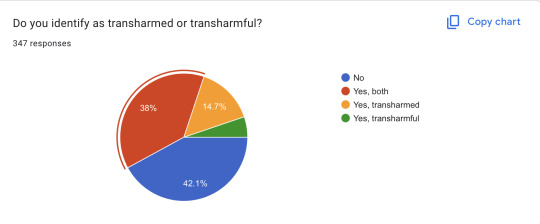
Responses to these were actually really fascinating and helpful. I could write a whole other post on it, honestly.
I’ll do my best to summarize here.
The majority of people who identify as transharmed/harmful fit both labels. You can see this in the chart. Besides that, transharmed seems more common than harmful.
Based on written responses, it is very clear to me that identification with these labels tends to stem from trauma. Though some also claimed they take them on for fun or for sexual reasons, many *many* people specifically talked about wishing their trauma was worse. Over and over again I saw sentences like, “I feel like my trauma wasn’t valid”, “I feel like it should’ve been more severe”, “people would believe me if I was more traumatized”, “I wish people would take my issues more seriously”.
This is a very common mindset among people struggling with trauma and/or mental illness. Many responders reported having these feelings about past experiences with grooming and childhood abuse. Feeling like something bad should’ve happened to you when you were younger is also often a sign of CSA or other traumatic memories that one might’ve blocked out; in other situations, it may also come from a lack of support for already existing issues.
In some cases, seemingly more commonly in those who identified with the transharmful label, people might seek out this transID to cope with or mitigate guilt from intrusive thoughts. It can be an outlet for anger, some reporting that they find a type of relief in fantasizing about hurting the people who hurt them, or hurting people in the same way they were once hurt. For many, transharmed/harmful was also related to plurality—specifically the existence of fictives/introjects and their own memories of their source material.
Though some expressed distaste for the way the general radqueer community seems to have conflated transharmful/harmed labels for kink and the want to seek out conabusive relationships, there were several people who said that they identified with these terms for specifically erotic reasons.
There was also a common theme of gratefulness for a space to express commonly taboo desire in a way that minimizes potential for harm. Especially for people who were once abused, being able to experience these things in a controlled environment was important; the desire to return to abusers themselves is considered common, so the want to recreate some aspects staying away from actual abusive situations was noted as incredibly helpful.
As some did point out in the survey, the similarities between conabuse and (sexual or nonsexual) BDSM are very apparent. Consent was consistently reiterated as necessary to many of these people, though a few also expressed concern with the way conabusive relationships have played out specifically in online spaces.
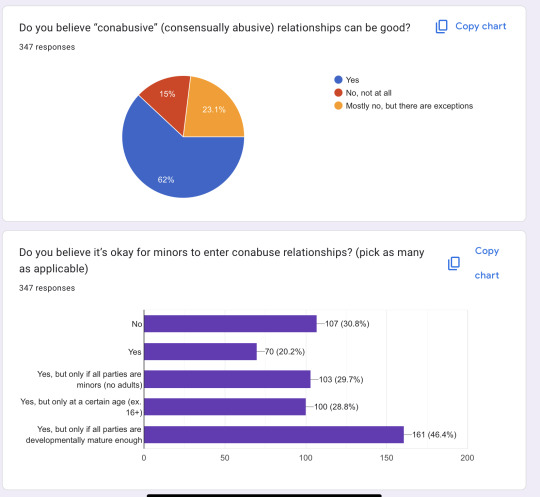
The majority of responders were positive or nuanced towards the concept of conabusive relationships. The question of minors engaging in such relationships seemed like it really depended on the individual situation for many. Maturity especially was a big factor.
—Contact Stances for ‘Big Three’ + Incest—
(TW for… all the stuff that’s involved in discussing that)

Just to preface, the reason I including the ‘regardless of consent’ answer was mostly for the section on beastiality, necrophilia and pedophilia—online, I have rarely seen the opinion that engaging sexually with beings that do not understand or relate to our societal concepts of sex (or are… corpses) cannot be harmed by it. I am also aware that some people simply don’t care about committing harm. I included it here for consistency.
Consensual incest was definitely one of the more accepted ‘taboo’ acts in this survey, with a majority of ~59%. Although, it’s important to note that for many people the pre-existing relationship of those involved would make a difference in their opinion.

Necrophilia was overall the most supported (adding up both the red and blue sections of the pie chart there). In written responses, I also saw people claiming that conditions such as relationship to the deceased and likelihood of contracting illnesses would also be relevant to their opinions. Interestingly, there seemed to be a higher percentage of anti-contact here than for incest; some who chose such an option mostly highlighted the issue of dead bodies not being able to revoke consent during the act, and therefore not having the ability to be fully consenting at all.

Zoophilia was not supported by the majority (71%). ~25% of responders believed consensual contact with animals was possible; out of those who did, the belief that animals can consent if they initiate contact was most popular (followed by perceived enjoyment and intelligence level). Interestingly, I got several responses from people who labelled themselves as either pro or anti contact zoophilia who claimed that they believed sexual contact with animals *could* hypothetically be done ethically, but that the vast majority of people do not have the knowledge of animal behavior and biology to do so.

Pedophilia/Hebephilia was considerably more divisive. Comparing the pie chart here with the data below, I believe it would be accurate to say that we have a majority (~59%) of people who believe youth cannot consent to adult advances, and others whose opinions seem to be more situationally-defined. Keep in mind that not everyone who answered the first part answered the second.
According to written responses, those that were pro or nuanced on the issue tended to prioritize maturity level and sexual education for minors. Some people claimed that kids of almost any age should be able to express consent to (a few specified: non-penetrative) sex in a society that better educated children on their bodies and relationships. There seemed to be a group of people who agreed that, philosophically, children have the capacity to say yes or no to sex in the same way they would for anything else—most of these people, though, agreed that this would not work in our society due to the prevalence of CSA and lack of protections for children.
I found it interesting that more people identified as anti-contact for zoophilia than pedo/hebephilia. I saw two or three responses that claimed it was mostly an empathy issue (more for animals, less for children); but a more common outlook seemed to be that—while some minors have the ability to communicate what they want and understand the culture we have around sex—animals cannot meaningfully consent within the framework of our society.
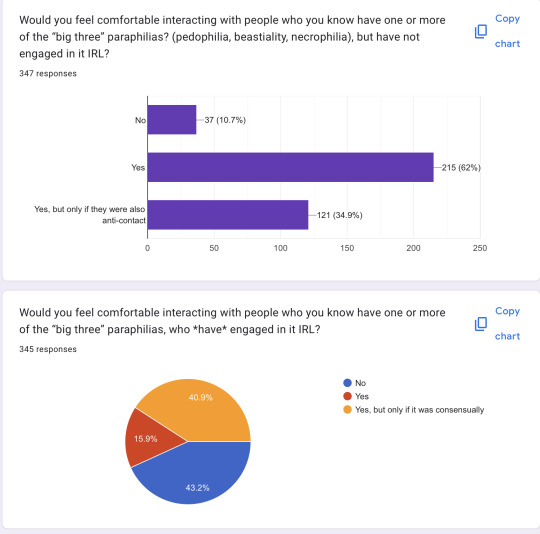
As we can see here, the majority (62%) of people would feel comfortable interacting with people who had one or more of the ‘big three’ paraphilias, but have not engaged in them. For many people (~35%) there is the additional caveat of being anti-contact.
For those who *have* engaged in any of those paraphilias, comfortability interacting falls significantly. There’s still a majority of people willing to interact (adding the yellow and red sections together), but most of the people in that category (~41%) would only be comfortable if they considered the other persons’ contact consensual. ~43% of people would not feel comfortable interacting at all.

I don’t have a ton to say on this chart, but I thought I’d include it here.
—CENSORSHIP—

I have less to say in this section, but I find it notable that (admittedly, by a small margin) people found the ethics of AI child pornography featuring real children’s faces (but not bodies) more disagreeable than fully real images of children. Also notably, ~27% of responders believe children can consent to keeping sexually explicit images/videos of themselves available. Based on written responses, I believe some or most of this percentage comes from people wanting it to be acceptable for youth to keep/potentially distribute nudes of themselves without fear of legal repercussion.

Here we have a majorities for not banning sexually explicit writing or animation portraying children. As I expected, writing has a little more support than visual depiction.
—CONCLUSION, NOTES—
Again, I want to thank everyone who participated. The survey will continue to stay open if you haven’t taken it and want to add your own perspective.
I still have some questions, particularly regarding the diversity in definitions of consent I saw, as well as some of the more… ‘cosmetic’ (?) based TransIDs that I’d be interested in understanding the thought behind.
I feel like I have a much better understanding of some of the psychology behind a lot of this, at least. I won’t go into any ultimatums here, because I believe they might be influenced by my own ethics, but I’ll just say that much of this community is very understandable if you take an empathetic approach. It’s interesting that an online culture so focused on being able to identify as ‘other’ in a very individualistic way seems to have also brought many people into community that they were seeking. There’s quite an emphasis on the shared solidarity between different “deviancies” (as societally-defined), and for better or for worse this has led to the public broadcast of the many diversities of opinion these people have on some of the most taboo subjects one can think of.
#radqueer#ex radqueer#post radqueer#transid#transabled#transage#transharmful#transrace#transharmed#anti rq#social research
131 notes
·
View notes
Note
https://twitter.com/ZakugaMignon/status/1739703106466627976?t=6BRheBvMK4MlCt5gXaj4ig&s=19
this is a comically misleading graph lol (copy-pasted it below)
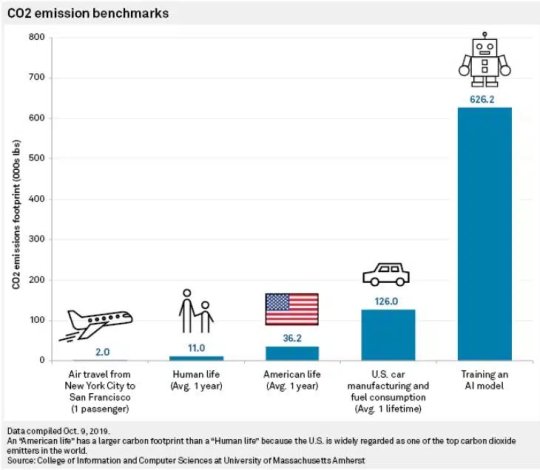
like you look at this and obviously think 'wow training an AI model is so much more carbon-intensive than planes or cars' -- but if you look at the actual units being chosen, they're fucking stupid. like, why is the air travel one the only one measured per passenger? the AI model will presumably be used by more than one person. fuck, even the average car will often be transporting more than one person! why is the car the only one that has its lifetime use and manufacturing cost combined when the AI model only has its manufacturing cost and the plane only has the cost of a single flight divided per passenger?
these are absolutely fucking nonsensical things to compare, and obviously chosen in ways that make AI look disproportionately bad (and air travel look disproportionately good, for some reason?). i'm not even touching the profoundly Fucked political implications of measuring the CEO emissions of 'a human life'
but let's, just for funsies, assume that these are reasonable points of comparison -- in 2021, 9 million cars were made in the USA. for the environmental impact of training AI to be even equal to the effects that those cars will have over their lifetimes (which this graph obviously seeks to imply), there would have to be over a million AI models trained in that time. which--hey, hang on a minute, that reminds me, what the fuck is 'training an AI model'! AI models come in all kinds of sizes -- i don't think the machine learning model that the spiderverse animators used to put the outlines on miles' face cost as much to train as, say, DALL-E 3! there is no indicator that this is an 'average' AI model, or whether this is on the low or high end of the scale.
so having just had that above question, i went to look at the original study and lol, lmao even:
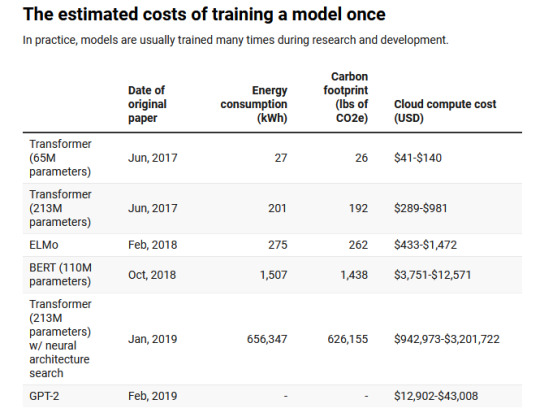
the 626,000 lbs figure is actually just the cost of that one specific model, and of course the most expensive in the study. there's no convincing evidence that this is a reasonable benchmark for most AI training -- for all this study's extremely limited set of examples tells us, this could be an enormous outlier in either direction!
so yeah, this is officially Bad Data Visualization, & if you originally saw this and thought "oh, it looks like AI art really has a huge environmental impact!" then, like, you're not stupid -- the person making this chart obviously wanted you to think that -- but i recommend taking some time when you look at a chart like this to ask questions like 'how was this data obtained?' and 'are these things it makes sense to compare on the same scale?', because there's a lot of misleading charts out there, both purposefully and through sheer incompetence.
372 notes
·
View notes
Photo

“Data Is Beautiful”: 30 Cool Guides, Charts, And Graphs That Make Learning Fun Again
19 notes
·
View notes
Text
For many years there has been intense discussion on the role and legitimacy of the jury vs the televote in the Eurovision Grand Final. The problem is that many of the arguments I see made are based on nothing but people's gut feeling and snap judgements from watching the show. And humans are notoriously terrible at intuiting statistics.
That's why I wanted to provide some actual data to give context to the more eye-catching examples people tend to use, and hopefully encourage some critical thought. I spent the afternoon updating my eurovision excel file with data from the 2024 and 2025 Grand Finals, and can now present these graphs of jury results plotted against the televote. As far as eurovision statistics go, this is one of the simplest charts you could make, and should hopefully be as simple to understand.
Terms: I use the term televote to refer to the entire public vote - this includes all votes from calls, texts, websites etc.
The axes: These show percentages out of the total number of jury or televote points awarded overall in a given show. Using this measure instead of the actual point scores ensures that results from different years are comparable, despite the fact that the number of Grand Final entries and overall points to be distributed between them varies from year to year (depending on the number of voting countries) .
Reference line: This shows where an entry would land if the juries and televote respectively awarded it an equal percentage of their available points. Data points that land above this line means the jury awarded the entry a greater proportion of its available points as compared to the televote, and vice versa. I find it interesting to see which entries land near this line, and then compare them to entries that stray further from it, in either direction. I also like to see where my favourites ended up, and consider how that can be understood in the context of the previous comparison.
First chart: Here each data point represents an individual entry in the Eurovision Grand Finals from 2016 to 2025 (aka every year with the current split scoring system). Data source: eurovisionworld.com

Second chart: These data points represent the average percentage out of the total jury/televote points each country was awarded between 2016 and 2025 (for the years that they made it to the Grand Final, that is).
Beware: For countries that made it to the final more times there are more data points to average, while for others there are as few as two results to work from.
Also beware: Averages can obscure variance - a country with epic highs and lows might end up looking similar one with stable middle-of-the-road results, despite their actual experiences being very different. That is to say: there are lots of outliers included in these averages - Spiders Georg has set up his cave and now lives in this chart. With his entire spider farm. Look at it. It's on the web.
Also-also beware: This chart makes the assumption that nationality is the most relevant variable to investigate in relation to the final result. But that remains an unproven assumption; before drawing any conclusions about potential biases the public or juries might have for certain countries, these results should be compared to charts where other factors are accounted for, to rule them in or out as compounding factors. Such factors could be running order, when the voting opens, genre, vocal ability, dancing ability, stage precence, visual production, creative cohesion etc.
In short, this chart doesn't rule anything in or out on its own—but it makes a good starting point for further investigation.

Country letter codes, for reference:

Not sure how viewable these charts will be on smaller screens, but for the lower scores on the detailed breakdown to be visible at all I needed to make them huge. Might fuck around and make the scale logarithmic at some point, to show more detail in the lower range without cutting off the upper. I also have more data tables with more complex calculations going on in this excel file. I might make charts of those at a later date, if I can first work out whether they provide any useful insights at all or were just fun to make. ¯\_(ツ)_/¯
Thanks for reading!
12 notes
·
View notes
Text
I love information I love things I love objects I love articles I love selections I love collections I love assortments I love categories I love lists I love graphs I love charts I love lines I love pens I love data I love maps I love demographics I love seeing and viewing and knowing and looking I love sentences I love paragraphs I love the spaces that break them up I love paper I love ink I love graphite I love patterns I love connections I love planning I love plotting I love identifying I love analyzing I love coming to conclusions I love sorting I love visualizing I love imagining I love understanding I love processes I love structrures
55 notes
·
View notes
Note
Wdyt? https://x.com/statisticurban/status/1860817868251869345?s=46
This shows that although straight men commit the most crime gay men commit less crime than straight women.
So, that's not what that study [1] says.
The thin lines on each bar in the graph represent an error bar; they're present to visually indicate the degree of uncertainty in the estimate. In this case, the bars for heterosexual women, homosexual women, and homosexual men all overlap. Since the true rate for each group may be anywhere within this range, this study cannot be used to confirm this claim.
In particular, if we look at the charts showing the actual statistical tests (which help us decide if any observed effects are "true" or simply an artifact of this sample), we see gay boys only show lower rates of delinquency than gay girls for non-violent delinquency as adolescents and for violent delinquency as young adolescents. This is important since we already know sex differences in crime – while still present – are less dramatic for non-violent crime and for adolescent offenders.
Furthermore, the "non-violent delinquency" measure included questions like "acting rowdy", which, while inappropriate in some contexts, is not a criminal behavior. Further, a potential issue with their "violent delinquency" scale is that it fails to consider instigation/self-defense. For example, they include "getting into a physical fight", but do not appear to consider if the child in question instigated the fight or if they were defending themselves against another child(ren). Considering the data collection took place in 1994-1995, when overt homophobia was far more acceptable, I consider this a substantial issue with the design.
And as an additional important note, these researchers actually included bisexual individuals in both the heterosexual and homosexual categories, by collapsing across the "homosexual and mostly homosexual categories" and the "heterosexual and mostly heterosexual categories". Aside from the homophobia on display here, this also means their claims may not even reflect their data. (Without the data itself, I cannot determine if including bisexuals in these categories affected the results.)
---
So what about some accurate statistics?
This 2024 longitudinal, representative, national Dutch study [2] found that while "men in same-sex relationships were less likely to be a suspect of crime compared to those in opposite-sex relationships" and "women in same-sex relationships exhibited higher risk than those in opposite-sex unions", men (of any sexuality) were still more likely to commit crime than women (of any sexuality), particularly for violent crime.
Unfortunately, given the design, this study was still not able to determine the relationship with bisexuality (i.e., an unknown number of people in both homosexual and heterosexual relationships are actually bisexual).
This review and meta-analysis [3] on youth indicates "sexual minority girls, [but not boys], are disproportionally involved in the justice system", but cannot speak to the relative rates of gay girls to gay boys. And, again, what is considered "delinquent" in an adolescent does not always correspond to an actual crime (e.g., truancy).
This review [4] further expands on perpetration research in sexual minorities and highlights the substantial limitations in the research. In general, gay and bisexual youth perpetration varies broadly by what specific violence is being studied as well as study methodology. There is some limited support for the trend discussed above (i.e., perpetration rates decreasing from straight men -> gay men -> gay women -> straight women), but in general the limitations in the reviewed research cautioned against any firm findings. (To be clear, this review took place before [2] which is a strong study on this topic. Hopefully, more will now follow.)
Finally, the discussed trend isn't necessarily an effect of biology, as that poster appears to be implying. It's possible that gay women and men are conforming – in part – to the gendered expectations of the opposite sex (i.e., gender nonconformity, whether positive or negative in this case).
(But, also, as a note: much of the difference between women in same sex and opposite sex relationships appears to be driven by traffic offenses.)
I hope this helps!
References under the cut:
Beaver, K. M., Connolly, E. J., Schwartz, J. A., Boutwell, B. B., Barnes, J. C., & Nedelec, J. L. (2016). Sexual orientation and involvement in nonviolent and violent delinquent behaviors: Findings from the national longitudinal study of adolescent to adult health. Archives of Sexual Behavior, 45(7), 1759-1769.
van de Weijer, S. G., van Deuren, S., & Boutwell, B. B. (2024). Same-Sex Relationships and Criminal Behavior: A Total Population Study in The Netherlands. Archives of Sexual Behavior, 1-16.
Jonnson, M. R., Bird, B. M., Li, S. M., & Viljoen, J. L. (2019). The prevalence of sexual and gender minority youth in the justice system: A systematic review and meta-analysis. Criminal Justice and Behavior, 46(7), 999-1019.
McKay, T., Lindquist, C. H., & Misra, S. (2019). Understanding (and acting on) 20 years of research on violence and LGBTQ+ communities. Trauma, Violence, & Abuse, 20(5), 665-678.
9 notes
·
View notes